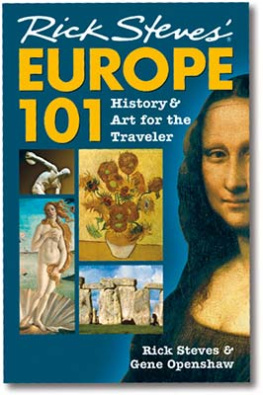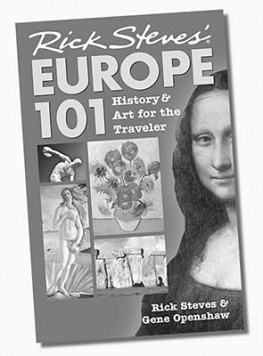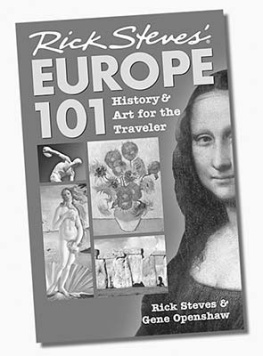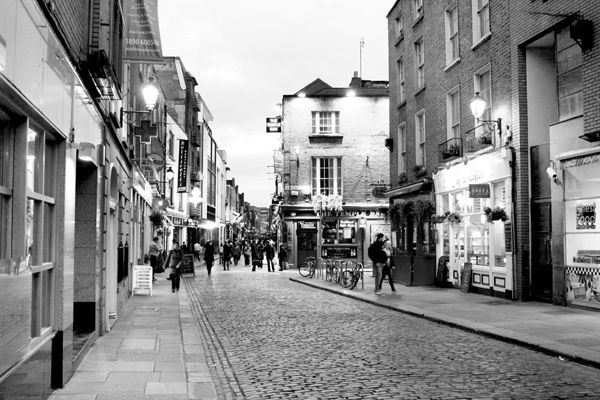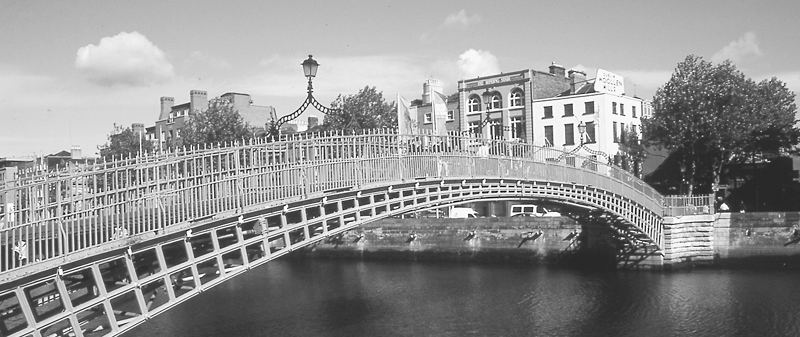Rick Steves'
SNAPSHOT
Dublin
This Snapshot guide, excerpted from my guidebook Rick Steves Ireland, introduces you to the city of Dublin. From its lively pubs filled with Guinness-fueled craic (conversation) and traditional music, to its stately Georgian sights, to its powerful rebel history, the Irish capital delights its visitors. Stroll vibrant OConnell Street for a lesson in Irelands long struggle for independence, cheer on the local hurling team at Croke Park, and pore over the intricately decorated ninth-century Book of Kells. Pious, earthy, witty, brooding, feisty, and unpretentious, Dublin is an intoxicating potion to sip or slurpas the mood strikes you.
For a break from the big city, venture to sights near Dublin: the prehistoric tombs at Br na Binne, the site of the pivotal Battle of the Boyne, the stout ruins of Trim Castle, the impressive Gardens of Powerscourt, the monastic settlement at Glendalough, and the proud Irish equestrian tradition at the National Stud.
To help you have the best trip possible, Ive included the following topics in this book:
Planning Your Time, with advice on how to make the most of your limited time
Orientation, including tourist information (abbreviated as TI), tips on public transportation, local tour options, and helpful hints
Sights with ratings:
Dont miss
Try hard to see
Worthwhile if you can make it
No ratingWorth knowing about
Sleeping and Eating, with good-value recommendations in every price range
Connections, with tips on trains, buses, and driving
Practicalities, near the end of this book, has information on money, phoning, hotel reservations, transportation, and other helpful hints.
To travel smartly, read this little book in its entirety before you go. Its my hope that this guide will make your trip more meaningful and rewarding. Traveling like a temporary local, youll get the absolute most out of every mile, minute, and dollar.
Happy travels!
Rick Steves
With reminders of its stirring history and rich culture on every corner, Irelands capital and largest city is a sightseers delight. Dublin holds its own above its weight class in arts, entertainment, food, and fun. Dublins fair city will have you humming, Cockles and mussels, alive, alive-O.
Founded as a Viking trading settlement in the ninth century, Dublin grew to be a center of wealth and commerce, second only to London in the British Empire. Dublin, the seat of English rule in Ireland for 750 years, was the heart of a civilized Anglo-Irish area (eastern Ireland) known as the Pale. Anything beyond the Pale was considered uncultured and almost barbaric...purely Irish.
The Golden Age of English Dublin was the 18th century. The British Empire was on a roll, and the city was right there with it. Largely rebuilt during this Georgian era, Dublineven with its tattered edgesbecame an elegant and cultured capital.
Those glory days left a lasting imprint on the city. Squares and boulevards built in the Georgian style give the city an air of grandeur (Georgian is British for Neoclassical...named for the period when four consecutive King Georges occupied the British throne from 1714 to 1830). The National Museum, the National Gallery, and many government buildings are in the Georgian section of town. Few buildings (notably Christ Church and St. Patricks cathedrals) survive from before this Georgian period.
But nationalismand a realization of the importance of human rightswould forever change Dublin. The American and French revolutions inspired Irish intellectuals to buck British rule, and life in Dublin was never quite the same after the Rebellion of 1798. In 1801, the Act of Union with Britain resulted in the loss of Irelands parliament (no need for two with the dominant one in London). As the Irish members of parliament moved to Westminster, the movers and shakers of the Anglo-Irish aristocracy followed suit, and Dublin slowly began to decay.
Throughout the 19th century, as Ireland endured the Great Potato Famine and saw the beginnings of the modern struggle for independence, Dublin was treatedand feltmore like a British colony than a partner. The tension culminated in the Easter Uprising of 1916, soon followed by a successful guerilla war of independence against Britain and Irelands tragic civil war. With many of its grand streets left in ruins, Dublin emerged as the capital of the British Empires only former colony in Europe.
While bullet-pocked buildings and dramatic statues keep memories of Irelands struggle for independence alive, the city is looking ahead to a brighter future. Dubliners are energetic and helpful, while visitors enjoy a big-town cultural scene wrapped in a small-town smile.
Planning Your Time
On a three-week trip through Ireland, Dublin deserves three nights and two days. Be aware that some important sights close on Mondays. Consider this ambitious sightseeing plan:
Day 1:
| 10:15 | Take the Trinity College guided walk. |
| 11:00 | Visit the Book of Kells and Old Library ahead of midday crowds. |
| 12:00 | Browse Grafton Street, have lunch there or picnic on St. Stephens Green. |
| 13:30 | See Number Twenty-Nine Georgian House (closed Mon). |
| 15:00 | Head to the National Museum: Archaeology branch (also closed Mon). |
| 17:00 | Return to hotel, rest, have dinnereat well for less during early-bird specials. |
| 19:30 | Go for an evening guided pub tour (musical or literary). |
| 22:00 | Drop in on Irish music in the Temple Bar area. |
Day 2:
| 10:00 | Take the Dublin Castle tour. |
| 11:30 | Hop on one of the hop-on, hop-off buses, jumping off to see the Guinness Storehouse and Kilmainham Gaol (bring a sandwich to munch in transit on the open-top bus, or stop off to picnic in one of Dublins green squares). |
| 15:00 | Leave the bus at Parnell Square, visit the Garden of Remembrance, and stroll down to OConnell Bridge, sightseeing and shopping as you like along the way. |
| Evening | Catch a play or concertor try the story-telling dinner at The Brazen Head. |
With More Time: Dublin, while relatively small, can keep you busily sightseeing for days without even leaving the center of town. And with all its music, theater, and after-hours toursnot to mention the lively pub sceneevenings are just as fun.
Greater Dublin sprawls with 1.2 million peoplemore than a quarter of the countrys population. But the center of tourist interest is a tight triangle between OConnell Bridge, St. Stephens Green, and Christ Church Cathedral. Within this triangle youll find Trinity College (Book of Kells), Grafton Street (top pedestrian shopping zone), Temple Bar (trendy and touristy nightlife center), Dublin Castle, and the hub of most city tours and buses. The only major sights outside this easy-to-walk triangle are the Kilmainham Gaol, the Guinness Storehouse, and the National Museum: Decorative Arts and History branch (all west of the center).


